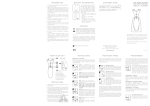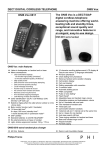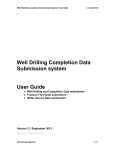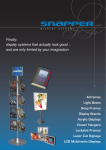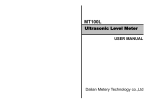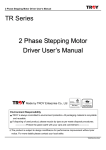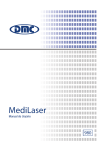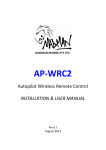Download Medi Laser Operators Manual.pub
Transcript
Medi Laser LS.100.IR LS.200.IR LS.300.IR http://www.lasertools.com.au Geodetic Supply and Repair http://www.geodetic.com.au Wangara Showroom Monday to Saturday Unit 7 - 7 Prindiville Drive Wangara Perth WA 6065 Telephone: +61 (08) 9409 4058 16 Fax: +61 (08) 9409 4068 © Copyright 1998-2003 MCE Lasers © Copyright 1998-2003 MCE Lasers Operator‛s Manual 1 This manual is an important part of your purchase. Please read it thoroughly before using your Medi Laser. We recommend that you record details of your purchase here so that the information is readily available if you ever need to contact Lasertools Australia. Serial Number:..................................................................................................... Date of Purchase:.................................................................................................. Purchased from: Lasertools Australia http://www.lasertools.com.au Wangara Showroom Unit 7, 7 Prindiville Drive Wangara, Perth WA 6065 Email Address: [email protected] Telephone: +61 (08) 9409 4058 Facsimile: +61 (08) 9409 4068 2 15 Specifications Warranty Statement of Limited Warranty Laser source Semiconductor laser Laser output Power Settings 20, 40, 60, 80, and 100 mW (LS.100.IR) 20, 40, 60, 80, 100, 150 and 200 mW (LS.200.IR) 20, 40, 60, 80, 100, 150, 200 and 300 mW Nominal wavelength 830 nm Beam diameter at output 2mm Beam divergence Typically 27º Internal Power supply Re-chargeable NiCad battery External Power Supply 240 VAC Continuous use 5 to 6 hours Charging time 5 hours Low battery indicator Red LED Power On Green LED Laser On Red LED Flashing Weight 1.8 kg without carry case 14 The Medi Laser is warranted to be free from defects in performance and workmanship for a period of twelve months from date of purchase. The warranty covers all costs of repair or replacement at the manufactures option. The warranty does not cover: 1 Obvious abuse. 2 Damage caused by extremes of temperature or intrusion of fluids to either the case or handpiece. 3 Damage caused by attempts to recharge the battery with a plugback other than that supplied by the manufacturer. 4 Replacement of lost broken keys The warranty is considered void absolutely if any attempt is made to repair, modify or recalibrate the unit whatsoever. In these circumstances the manufacturer reserves the right to charge for costs incurred in repair of replacement of the unit. LTA is not liable for: 1 Freight charges incurred in return of defective unit to manufacturer. 2 Loss of income or inconvenience relating to defect in performance of the unit. 3 Leasing charges of alternative equipment during repair of a defective unit. LTA requires that the customer make reasonable attempts to inform the manufacturer of problems with the product prior to returning the unit for repairs. LTA, its agents or its representatives will not be held liable for any perceived inadequacy or failure of treatment undertaken with the product. L T A issues no representations either expressed or implied as to the effectiveness of laser therapy. The information contained herein or otherwise supplied to practitioners is merely advisory in nature and does not purport in any way to represent professional clinical technique or procedure. 3 Notes for guidance The L T A Medi Laser is an Australian made laser product. The following notes should be read carefully before using the laser. Laser radiation can be harmful if used incorrectly, and all safety precautions must be adhered to. Laser Safety The Medi Laser emits near infra-red radiation in a weakly divergent beam. The possibility of permanent retinal damage exists if the direct beam or specular reflections are viewed without the protection of a suitable optical filter. Before attempting any operation with the Medi Laser, it is essential that the operator read and be fully conversant with the following precautions: 1. Never direct the laser beam into the eyes of the patient or other person within the treatment area. 2. Do not stare or allow other persons to stare into the laser beam. 3. It is recommended that a pair of safety glasses, capable of absorbing infra-red radiation, be available. 4. Remove polished or highly reflective equipment and fittings from the treatment area to reduce the incidence of specular reflections. Glass fronted cupboards, mirrors and stainless steel surfaces fit into this category. 5. Ensure that the treatment area is well lit so that the pupil of the eye is well contracted. 6. Allow laser operation only when the handpiece tip is pressed firmly onto the tissue surface. 7. Ensure that the patient is never left unattended with the equipment when in an active condition. 8. Remove the key from the Medi Laser after treatment. Only responsible personnel should have access to, or be allowed to operate the equipment. Nominal Ocular Hazard Distance (NOHD) for the Medi Laser is 52 cm. The NOHD allows for intra-beam viewing with a 172 milliradian of axis divergence. 4 13 Care and maintenance To preserve the appearance of the Medi Laser and to ensure continued correct functioning of the instrument, please observe the following precautions: 1. Avoid exposure to extremes of temperature, for example direct sunlight. 2. Do not expose to rain or allow ingress of fluids into the case or handpiece. 3. Do not twist, kink or knot handpiece cable. 4. Do not attempt immersion sterilisation of the handpiece past the level of the handpiece tip. 5. Do no scratch the surface of the GRIN lens in the handpiece tip. Removal of the anti-reflection coating will affect laser output. 6. Do not clean any part of the case or handpiece with solvents including acetone, hydrocarbon thinners and turpentine, abrasive cleaners or cleaning solutions containing ammonia or chlorine. The Medi Laser may be cleaned when necessary by sparing application of a mild detergent solution or domestic silicone polish such as Mr. Sheen. The Medi Laser requires no further maintenance by the operator. Repair of any defect or malfunction must be performed by the manufacturer. Contents Warranty 3 Notes for guidance 4 Introduction 6 Operational Features 6 Principles of Operation 7 Operation of the Medi Laser 8 Lamp Illumination 8 Selecting Power 9 Battery Charging 9 Clinical Application Guides and Helpful Hints 10 10-11 Care and Maintenance 12 Laser Safety 13 Specifications 14 To maintain optimum effectiveness of the instrument, LTA recommend that the laser be checked periodically against a frequency compensated power meter. The laser power output may be adjusted internally to compensate for degradation over time of the lens and ageing of the laser diode. Power calibration is a delicate process and should not be attempted by any person without 12 5 Introduction The LS.100.IR is a phototherapy instrument intended for medical use. Applications include, but are not limited to, the following: • Acupuncture point stimulation. • Reducing inflammation of the joints following sprains, ligament and capsular injuries. • The relief of pain, particularly in the treatment of chronic osteo-arthritis. Treatment of muscular ailments, oedema reduction and • revascularisation. • Improving the manual treatment of contractures. • Promotion of cell regeneration to accelerate the healing of open wounds. • Treatment of skin disorders including acne vulgaris, roseacea and eczema. • The treatment of various neural ailments. Two specific texts on low-level laser therapy are: Clinical Laser Therapy Low level laser therapy J. Kert & L. Rose Scandinavian Medical Laser Technology, 1989 Lower level laser therapy A practical introduction T. Ohshiro & R.G. Calderhead John Wiley & Sons, 1988 While no attempt has been made in the context to outline every possible application, MCE is confident that the LS.100.IR will remain a versatile and enduring instrument in your practice. Operational Features The LS.100.IR consists of a desk standing case with an integral handpiece, via a flexible connecting cable. The case contains all control electronics, a rechargeable battery and battery charging circuit. The handpiece contains a 830 nm (near infra-red) 20 - 100 mW semiconductor laser coupled to a graded lens in the handpiece. The activating switch is conveniently located on the handpiece . 6 11 Clinical Application Effective treatment is dependant upon application of the correct POWER DOSAGE. Dosage is generally expressed in units of power; the Medi Laser provides a selection of five pre-determined dosages ranging from 20 mW to 100 mW in 20mW increments. Larger dosages are obtained by repeated applications of the selected dosage. A guide to standard dosages for particular treatment conditions is available in various published textbooks on low level laser therapy. Guides and helpful hints 1. 2. 3. 4. 10 Ensure that the handpiece tip is pressed firmly into the tissue surface during treatment. This ensures that refractive losses from air between the handpiece lens and tissue surface are minimised, and reduces divergence of the beam. Ensure that the handpiece is held perpendicular to the tissue surface. Keep handpiece stationary for the duration of laser emission. The practice of ‘scanning’ i.e. covering a wide area with a moving beam, is not advised. Greater depth of penetration is achieved if the dosage is concentrated at one point. The effect of the treatment is transmitted from the treatment point to the surrounding tissue. Use a connective medium between the handpiece lens and tissue surface. The connective medium insures that air is absolutely excluded, and also fills microscopic surface aberrations thus reducing the energy lost from tissue reflection. Examples of connective mediums are water, alcohol, oil and clear gels. Principles of Operation The Medi Laser has four switches, two of which are adjustable. • Laser Power Control is used to adjust the power of the laser diode. Five settings are available 20mW, 40mW, 60mW, 80mW and 100mW. • Timer Control is used to adjust time of exposure to power of laser diode. Five settings are available; 15 seconds, 30 seconds, 40 seconds, 50 seconds and 60 seconds. • On/Off switch function is explained in the table below. 240V AC External Power ON / OFF Switch Function OFF OFF Unit is OFF ON OFF Internal batteries are charged OFF ON Laser is working ON ON Laser is working and internal batteries are charging. The Medi Laser is using • Lock Switch used to protect unauthorized use of equipment. Please note that each Medi Laser is supplied with a unique key combination. Two keys are supplied. The loss of both keys will require replacement of a key-switch. MCE recom mends that one key be removed and stored in a safe place. When Low Battery LED is on the battery needs to be recharged. During recharging, the Medi Laser use an external power source of 240 V AC (a standard power point). 7 Operation of Medi Laser Switching Medi Laser on Insert key into key-switch. The Medi Laser will remain OFF while the key is in the horizontal position. The key may be removed from the horizontal position to prevent unauthorised operation of the laser. The Medi Laser is switched on by turning the key clockwise. For convenience, the key may also be removed from the ON position. Lamp Illumination The Green POWER lamp will light when power is supplied. Continuous illumination of the POWER lamp indicates that the internal battery has sufficient energy for continuous operation. The LOW BATTERY indicator is the red lamp on the top left hand corner. When LOW BATTERY indicators is illuminated, the power plugback must be connected. Selecting Power The LASER POWER CONTROL enable the selection of five predetermined dosages ranging from 20 mW to 100 mW, in 20mW increments. Set the power control to correspond to the desired dosage. A single press of the handpiece button enable the Medi Laser to emit laser radiation for a period corresponding to the time on the TIMER CONTROL. (It is not necessary to keep the handpiece button depressed in order to maintain laser emission). Subsequent operation of the handpiece button, while in operation has no effect on the delivered dosage. The treatment can be cancelled at any time by switching the KEY to the OFF position. Battery Charging The internal NiCad battery is recharged by a current source with a current limiting. Power is supplied to the battery charging circuit by connecting the 1external power source 240 VAC A battery lifetime of up to 1000 recharges may be expected with sensible observance of the following points: a) allow battery to fully discharge before connecting plugback b) fully charge battery before further use c) avoid sporadic battery charging. NiCad cells remember their charge and discharge states and prefer to operate between these limits. Continual trickle charging will tend to reduce the battery capacity. A fully charged battery will allow up to six hours of operation. Allow approximately five hours for re-charging the battery. The Medi Laser may be operated with the plugback connected if required, but this is not recommended. 8 9








